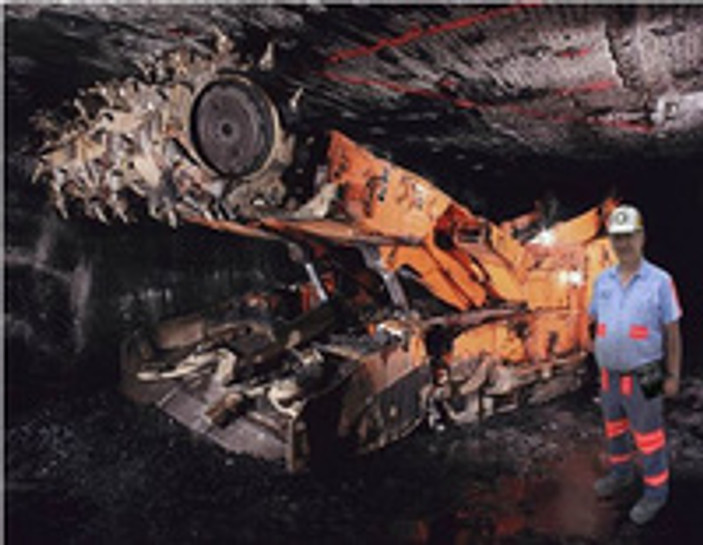MSHA News Release: [01/13/2015]
Contact Name: Amy Louviere
Phone Number: (202) 693-9423
Email: Louviere.Amy@dol.gov
Release Number: 15-0035-NAT
MSHA's Main: 'Proximity detection final rule will save miners' lives'
ARLINGTON, Va. — Wielding a large rotating steel drum equipped with sharp tungsten carbide teeth, a continuous mining machine scrapes coal from the mine's seams and drops it onto conveyor belts or into shuttle cars for transport to the surface. As it moves from one tight space to another underground, the massive machine leaves little room — and margin for error — for miners in its path. This high-powered scraper is one of the most efficient methods for extracting coal, yet not without its risks.
Thirty-five coal miners have died since 1984 when they became pinned, crushed or struck by continuous mining machines. To combat these kinds of accidents, a number of mining companies have adopted the use of proximity detection, a technology that uses electronic sensors to detect motion or the location of one object relative to another. These systems can be programmed to send warning signals and stop machines before they injure or kill miners working in the confined space of an underground coal mine.

"Simply put, the proximity detection final rule will save lives and has the potential to dramatically improve the safety of mining operations," said Joseph A. Main, assistant secretary of labor for mine safety and health. "It already has the support of many in the mining industry. In fact, a number of coal companies installed proximity detection systems long before there was a legal obligation to do so."Today, the Mine Safety and Health Administration announced a final rule that will require operators of underground coal mines to equip continuous mining machines with proximity detection systems. It will be published in the Federal Register on Jan. 15 and become effective 60 days thereafter.
With the new rule, a proximity detection system consists of machine-mounted components and miner-wearable components worn by each miner on the working section. The final rule establishes performance and maintenance requirements for these systems and requires training for persons performing the installation and maintenance.
To meet the standards set in the rule, a proximity system must:
- Cause moving or repositioning continuous mining machines to stop before contacting a miner;
- Provide audible and visual warnings on the miner-wearable component and a visual warning on the machine before it stops;
- Provide a visual signal on the machine that shows the machine-mounted components are functioning properly;
- Prevent movement of the machine if any machine-mounted component is not functioning properly (except limited movement for repairs);
- Prevent electrical interference that adversely affects the performance of other electrical systems in the mine;
- Be installed and maintained in proper operating condition by a trained person.
The rule includes phase-in periods of 8 to 36 months to give mine operators ample time to obtain MSHA approvals, modify continuous mining machines to meet the new requirements, and provide training to miners. The phase-in periods are based on the availability of four MSHA-approved proximity detection systems, the estimated number of continuous mining machines that would be rebuilt or replaced by new machines during the phase-in periods, and manufacturers' capacity to produce and install these systems.
Approximately 425 continuous mining machines have been equipped with proximity detection systems, and MSHA believes the majority of these systems will meet the provisions of the final rule with only minor changes, such as adding warning signals. There are about 863 continuous mining machines in underground coal mines.
Since 2002, MSHA has actively worked with the mining community to identify and investigate proximity detection technologies for preventing accidents. In February 2010, the agency published a Request for Information on proximity detection systems in theFederal Register and a proposed rule in August 2011. The agency held four public hearings where MSHA received comments from the mining public.
Alliance Resource Partners, L.P., which operators 11 mining complexes in the Illinois Basin and Appalachia, has been a pioneer in installing the technology on continuous mining machines. The company currently has 82 continuous mining machines equipped with proximity detection systems. Other mining companies, such as Alpha Natural Resources, Affinity Coal Co. and CONSOL Energy also employ the technology.
"Alliance is appreciative that Joe Main of MSHA is visiting the Gibson North mine today to highlight the importance of the use of proximity detection systems in underground mining operations," said Joe Craft, president and CEO. "Safety is Alliance's very top priority, and our team is committed to serving as an industry leader in the use of safety technology. As part of this commitment, Alliance has been at the forefront of designing and installing proximity detection systems at all of its mining operations and believes that they save lives."

